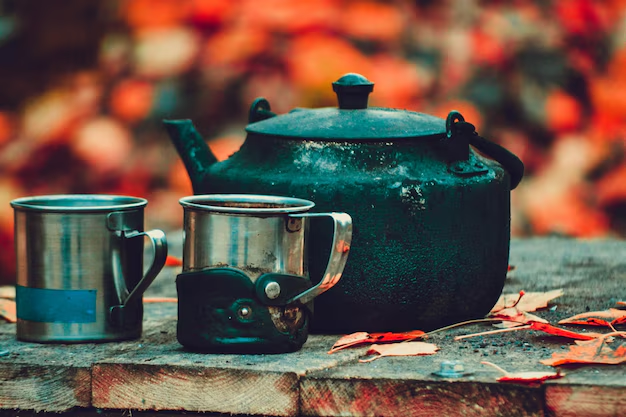In the stillness of a kitchen dawn, a teapot waits — silent, patient, hopeful for warmth. Over its head lies a tehuva (plural tehuvor) — a soft cloak of fabric and care, keeping tea’s steam close, whispering comfort.
This is not a mere ornament. It is a gesture: of warmth, home, intimacy. It is the poetry of fabric against porcelain.
Let us wander into the world of tehuvor — their origins, craft, meaning — and see how such a humble cover becomes a quiet song in the everyday.
What Is a Tehuva / Tehuvor?
The Swedish word tehuva (plural tehuvor) refers to a tea cozy — a cloth cover laid over a teapot to keep the tea warm and to decorate the table. In homes and traditions across Sweden and beyond, theuvor blend utility with beauty.
The textiles you see in crafts and shops often feature rich fabrics, embroideries, patchwork, and careful stitching. They live in kitchens, comforting each other.
In Swedish textile and design shops, “tehuvor” appear often under kitchen & dining textiles, sold in a series of decorative styles.
The History and Cultural Thread
Tea cosies themselves originate from times when insulating a teapot kept precious cups warm longer. Over centuries, they became domestic art. In Sweden, theuvor have woven into the fabric of craftsmanship — handed down, sewn with love, enriched with pattern.
Vintage tehuvor from the 1950s and 1960s shows cross-stitch, embroidery, and carefully designed motifs.
Today, designers like Svenskt Tenn offer the products in modern patterns, blending tradition and contemporary aesthetics.
In handmade craft circles, theuvor also appears in patchwork, upcycled fabrics, and creative textile design — a transformation of scraps into something warming.
Why Tehuvor Matter: Beyond Function
Warmth & Intimacy
A tehuva holds heat, but also holds intention. It says: This moment is worth lingering. It protects your tea; it protects the quiet ritual.
Home as Canvas
When a tehuva is embroidered, patterned, and matched to decor, it becomes part of the home’s visual poetry — a soft accent of domestic love.
Making & Memory
Sewing a tehuva is an act of presence. The stitcher’s hands slow, choosing fabric, pattern, thread. Each tehuva can carry memory: a grandmother’s scraps, a leftover dress, a printed image.
Gift & Ceremony
In many homes, a tehuva is given as a gentle gift — a blessing of warmth. It becomes heirloom, carried into new kitchens and new tea tables.
Crafting a Tehuva: Materials & Techniques
Materials
-
Cotton & linen: breathable, washable, classic.
-
Wool or fleece lining: adds insulation.
-
Patchwork fabrics: scraps sewn into quilts of color.
-
Embroidery threads & appliqué: for decorative motifs.

Techniques
-
Patterning: The shape often fits the pot’s dome — wide base, tapering top.
-
Patchwork/quilting: combining small squares or shapes into a larger whole.
-
Embellishment: floral motifs, birds, folk designs, initials.
-
Lining and interfacing: give strength and insulation.
-
Finishing: top loop (for lifting), side seams neatly bound.
Craftspeople sometimes repurpose old garments — a skirt transformed into a tehuva, threads and all — giving new life to fabric.
Design Styles & Motifs in Tehuvor
-
Traditional Swedish motifs: florals, folk ornamentation, stylized plants.
-
Modern prints: geometric, graphic, Scandinavian minimalism.
-
Patchwork & repurposed fabric: combining stories in cloth.
-
Novel patterns: elephants, stripes, animals (as seen in modern tehuvor)
Designers (like Svenskt Tenn) include theuvor in collections, pairing them with everyday table settings, making them decorative and functional.
Using & Caring for Your Tehuva
-
Placement: Always remove the tehuva before pouring, to avoid stains or smudges inside.
-
Washing: Follow fabric care (gentle wash for patterned fabrics, wool care if lined).
-
Storage: Keep flat or lightly folded to preserve shape.
-
Refresh: Over time, fabrics fade — a refashion or new lining can breathe fresh life into a cherished piece.
Tehuvor in Contemporary Life
While the digital age presses speed, the hour reminds us of slow, sensate rituals. In cafés, craft shops, and design boutiques, you’ll see them reemerging — small touches that restore tactility.
In online craft communities, crafters share patterns for the hobby, exchange ideas, and revive traditional sewing.
Svenskt Tenn lists theuvor along with kitchen linens — framing them as essential design elements, not mere accessories.
Retailers in Sweden offer theuvor under “Porslin & Servering / Tehuvor.”
A Poetic Pause: The Whisper of Steam and Cloth
Think of a tehuva as a lullaby to your tea. Steam rises, paused by soft fabric, staying warm like a whispered promise. The cup you pour becomes intimate: captured heat, comfort shared.
In a tehuva’s hush, there’s memory and hope. It holds not just tea, but care. It holds the hands of ancestors who stitched, the dreams of someone yet to brew.
Conclusion: The Soft Crown of Tea
Tehuvor are small, gentle deities of the tea table — silent guardians of warmth. They stitch function and beauty, heritage and home, into a single cloth.
In every tehuva, we find the hum of daily ritual, the voice of the maker, the invitation to slow down. So when your teacup waits, drape that cloth—not just to warm your brew, but to warm your soul.
Let your next tehuva be more than cover. Let it be a poem you set over your tea.
FAQs
1. What does “tehuvor” mean?
It is the Swedish plural of tehuva — tea cozy(s), cloth covers for teapots.
2. Are theuvor still used today?
Yes — in homes, craft shops, and design boutiques, both for function and aesthetic.
3. What fabric is best for a tehuva?
Cotton or linen with a warm lining (wool or fleece) often balances aesthetics and insulation.
4. Can I make a tehuva myself?
Absolutely. Many makers use patchwork, quilting, and embroidery — using patterns shared online.
5. How do I care for a tehuva?
Gentle washing, proper storage, and occasional refreshing of the lining will keep it alive through many tea seasons.
